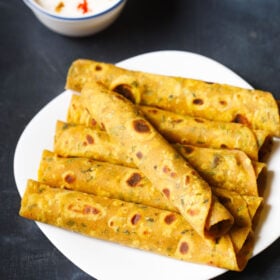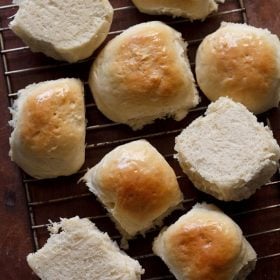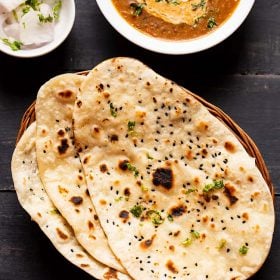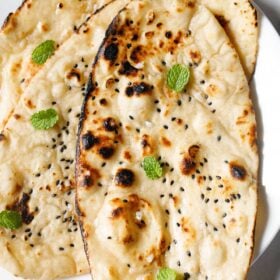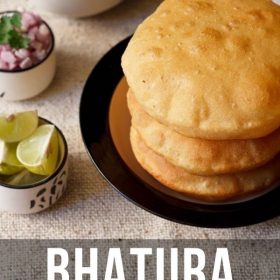Bhatura is a leavened fried bread from the Indian cuisine and is served with Chana Masala. Bhatura or Bhature (plural) is one of the most popular Punjabi recipes. There are many variations of making these crispy and fluffy fried bread. Dry active yeast, baking soda, eno (fruit salt), baking powder are some of the ingredients that are added to leaven the dough.
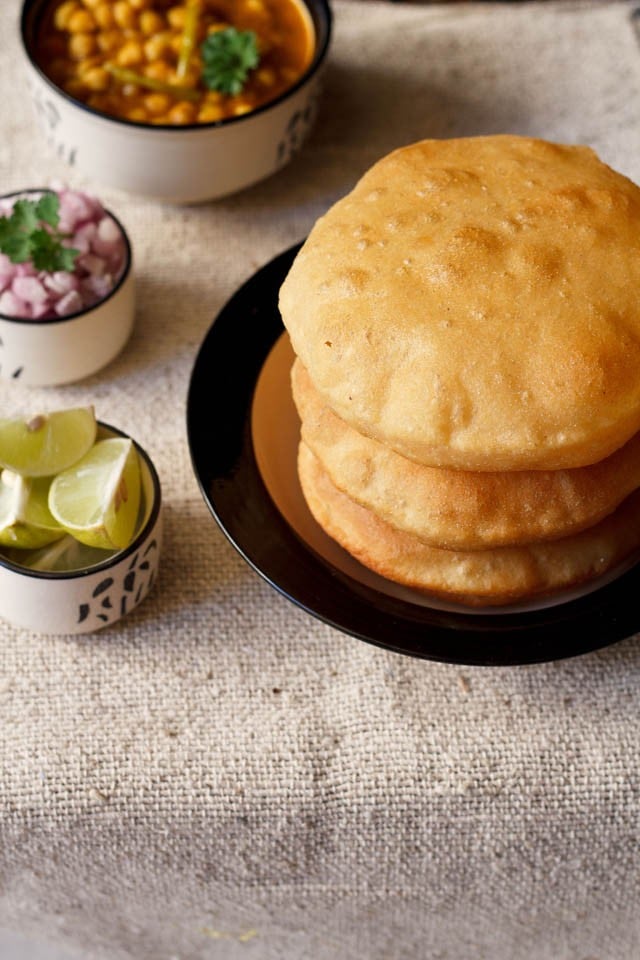
In this post I am sharing 2 delicious ways to make bhatura.
- No Yeast Naturally Fermented Bhatura – Made majorly with whole wheat flour using natural fermentation.
- Quick & Instant Bhatura – Made with Baking Soda and the dough just needs to be kept for 2 hours.
Both the recipes taste good and you can choose as per your time preferences. My personal favorite is the fermented bhatura recipe as the fermentation process adds those lovely sour aroma and taste in the bhatura. The instant bhatura taste very different than the fermented one.
Table of Contents
About No Yeast Bhatura Recipe
These no yeast bhatura are soft, fluffy from inside and crisp from outside. The way a bhatura’s texture ideally should be.
The recipe use a mix of both whole wheat flour (atta) and all-purpose flour (maida). You can also make this recipe with either all-purpose flour or whole wheat flour or a mix of both.
I have been making this awesome bhature for many years. The recipe has never failed me. I started making these bhature after adapting it from The Hare Krishna Book of Vegetarian Cooking by Adiraja Dasa.
When I had adapted the recipe for the first time, it was a super success. That time, when I fried the bhatura in oil, they not only puffed up but they puffed up really well – like the way the bhatura actually has to puff up.
I prefer making with version of bhatura as it is a fermented recipe and also made with whole wheat flour. Thus making it a slightly healthier version than the other bhatura recipes.
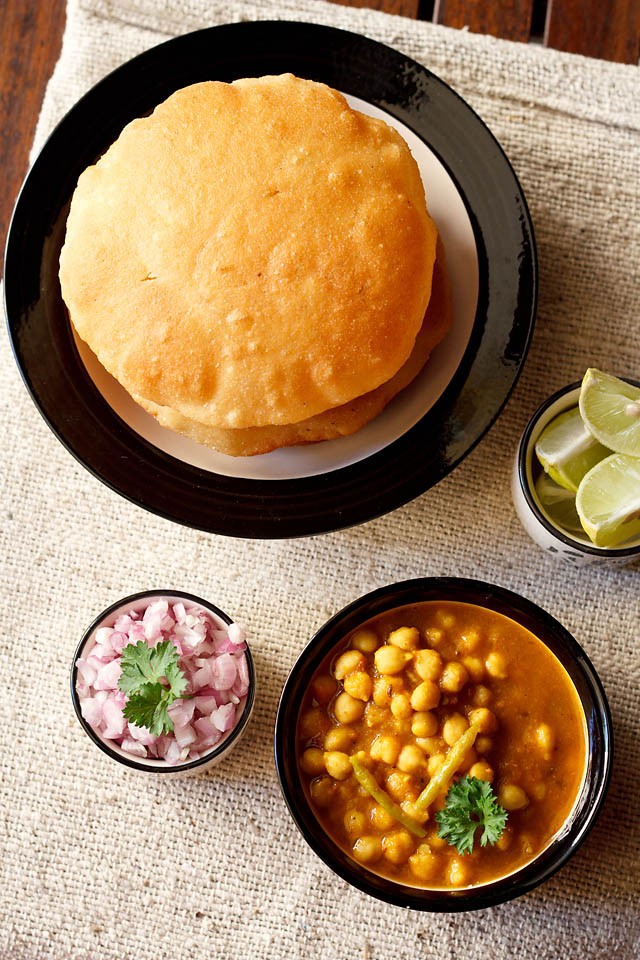
Why this recipe is a keeper
- Less all-purpose flour (maida, refined white flour) and more whole wheat flour (atta) – The ratio of all purpose flour to whole wheat flour used in this recipe is approximate 1:3 respectively. Some of the other bhature recipes are made of only all purpose flour. Though you can make this recipe completely with either all purpose flour or whole wheat flour.
- Made without yeast – The leavening is done naturally and similar to a sourdough starter. But here the starter has curd (yogurt) and baking powder or baking soda. This technique is the traditional Indian method to draw natural yeast from the air which helps in the leavening of the dough. In Hindi language it is also called as making “khameer” – where the word khameer refers to yeast. The bacteria culture in the curd (yogurt) also helps in fermentation.
- Fermented dough – The flour starter is allowed to leaven and ferment overnight. So the dough has the typical aroma and sour notes of fermented food. The rolling and frying of the bread takes around 20 to 30 minutes. But the leavening of the flour mixture, takes 8 hours (overnight) plus 2 hours. The time also depends on the temperature conditions. So keep the starter and the dough in a warm place.
- Fluffy and crisp – Since the dough is leavened and fermented, the bhature has a nice fluffy texture from within and puffs up really well in oil. Even though whole wheat flour is used in the recipe, you won’t feel the difference – the overnight fermentation help in giving a good soft texture to the bhatura.
- Stays soft even after cooling – Usually, bhature becomes chewy after cooling at room temperature. But these bhature stay soft.
The old pics have been updated with new pics, since I always end up making no yeast bhatura this way to go with chana masala on festive or special occasions. I love fermented foods and when I have time I always go for this tried and tested bhatura recipe.
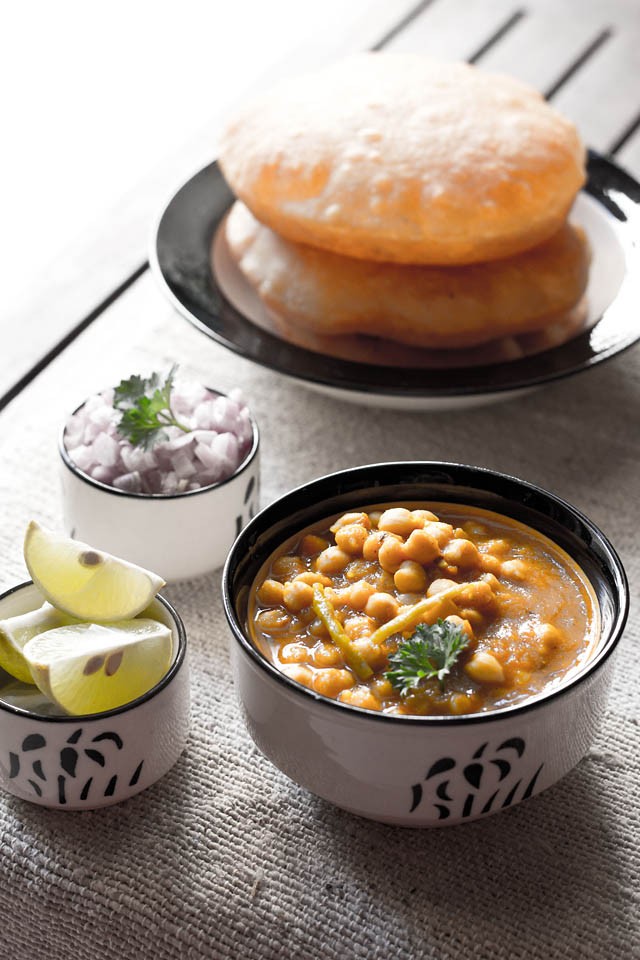
Bhatura are often eaten with Chana Masala (Indian chickpea curry) and this combination of Chole Bhature is very tasty as well as popular all over India.
How to make Bhatura (No Yeast)
Prepare The Starter
1. You will have to start the night before. In a bowl take fresh yogurt (curd), sugar, baking powder and all purpose flour (maida). Mix well all the above 4 ingredients.
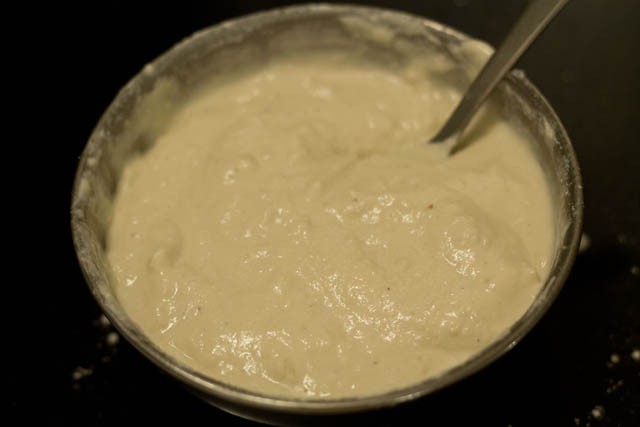
2. Cover the bowl with a cloth or lid and set it aside in a warm place overnight or for 8 to 9 hours to allow natural fermentation to take place.
The next day you will see tiny bubbles on the surface of the mixture. I stirred the mixture and so the bubbles cannot be seen in this picture.
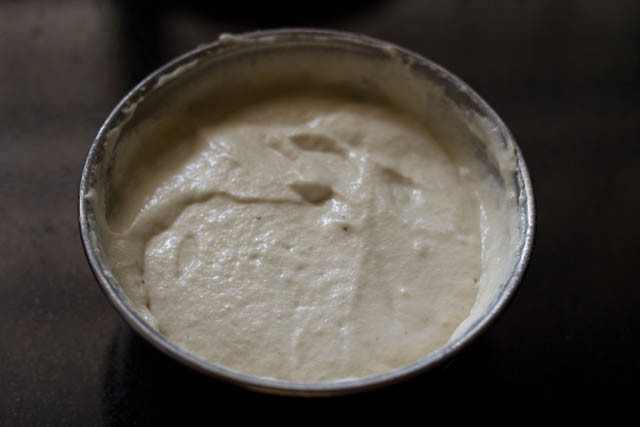
Form Dough
3. In another bowl, mix together the wheat flour with salt and rub the oil or ghee or butter into it with your fingertips.
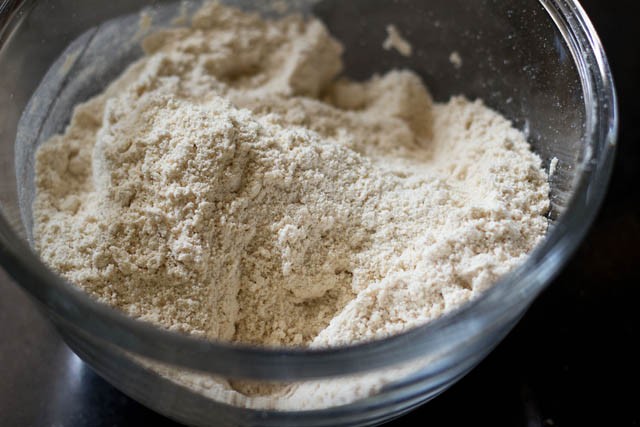
4. Into this bowl, add the fermented mixture and the warm water.
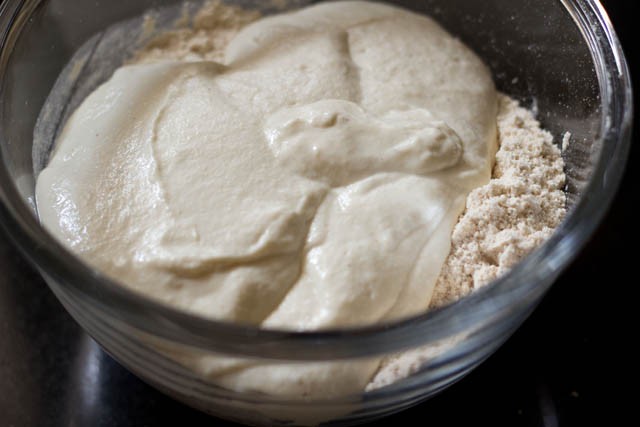
5. Mix everything well.
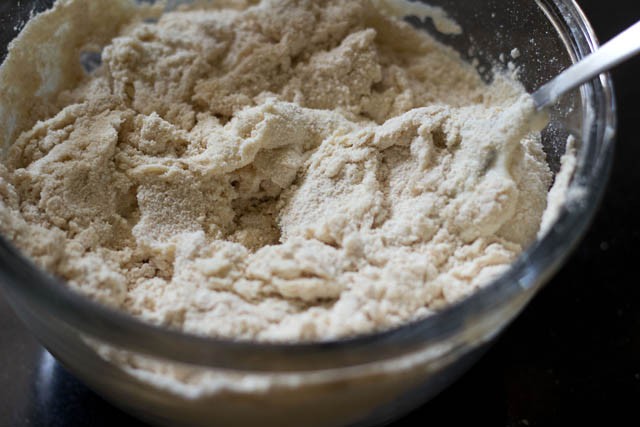
6. Knead into a dough for 5 to 10 minutes or until it is smooth. Add a little flour if it is too wet.
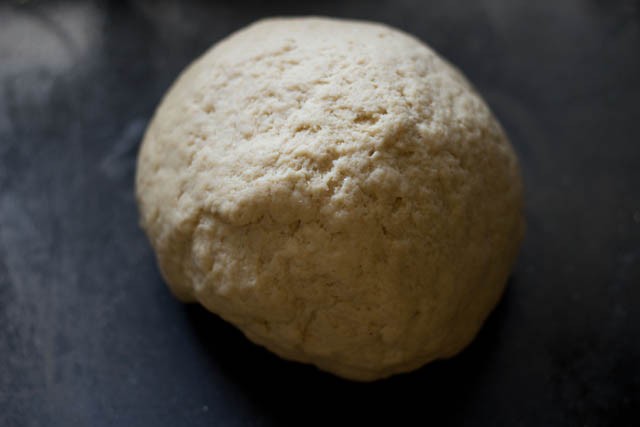
7. Gather the dough into a compact ball and cover it with a damp cloth. Again set it aside in a warm place for 2 hrs. This is how the dough appears after 2 hours.
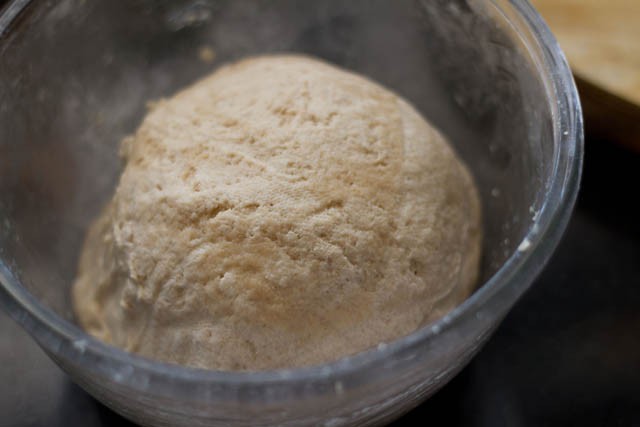
Assemble, Roll & Deep Fry
8. Knead the dough again. Shape into 12 to 15 balls.
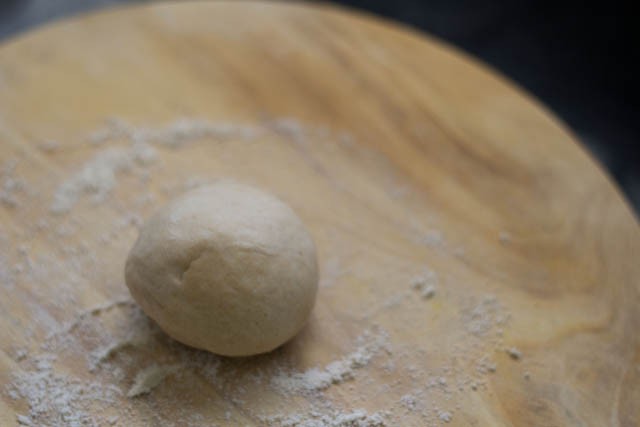
9. Roll each into 4 to 5 inch discs.
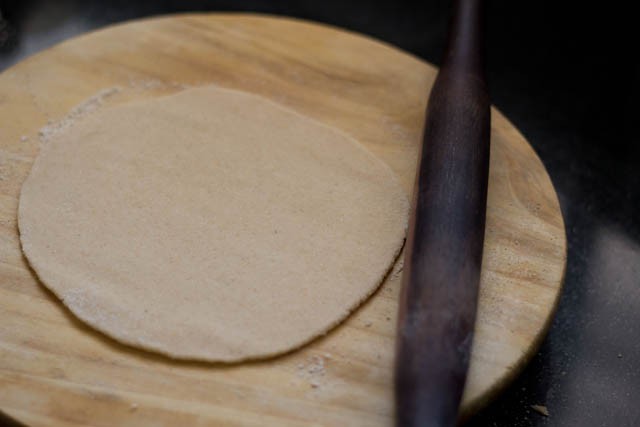
10. Heat oil or ghee and deep fry the bhatura in the same way as you would fry pooris. The oil has to be moderately hot.
Use medium to medium-high flame while frying. When one side is golden, gently flip and fry the second side.
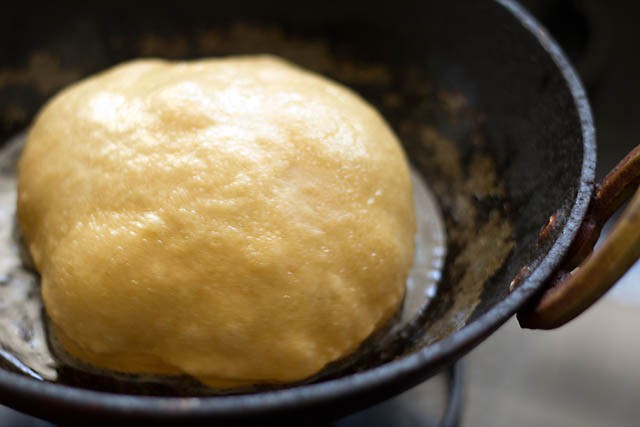
11. Fry them till golden and crisp. The bhatura will take a bit longer to fry than Poori.
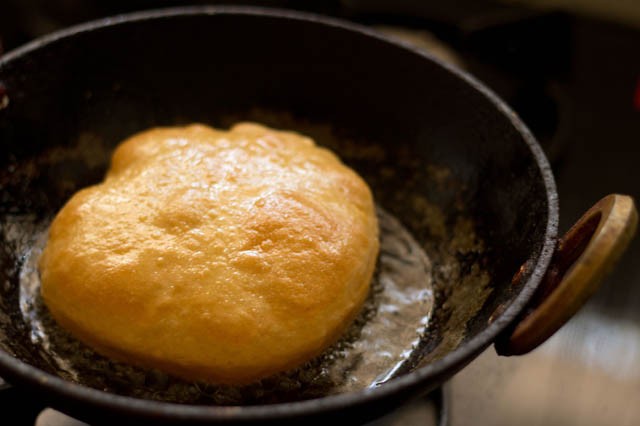
12. Drain them on kitchen paper napkins to remove the excess oil.
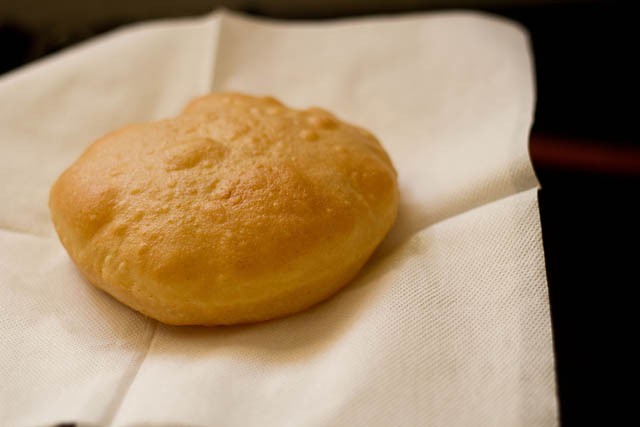
13. Continue to fry each bhatura this way.
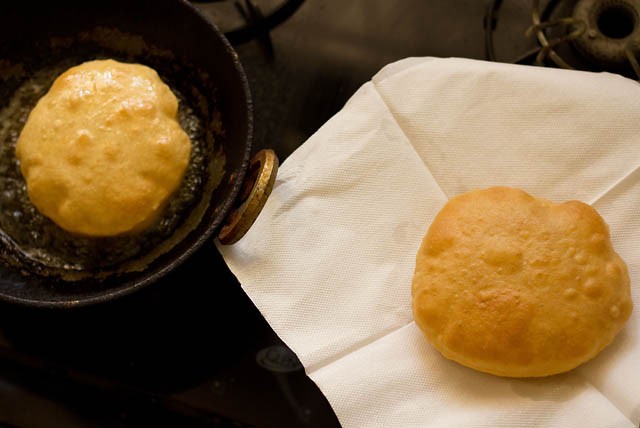
14. Serve the Bhature hot with Chana Masala or Amritsari chole or Aloo Chole. Also serve wedges of lemon and sliced onions along with the chole.

About Instant Bhatura
Instant Bhatura with baking soda that is easy and quick to make. This recipe as the name suggests is made with baking soda.
For leavening the dough, both baking soda and yogurt are used. The dough just needs to be kept for 2 hours to leaven and thus takes less time.
After 2 hours when the dough is leavened, you can then begin with rolling and deep-frying. When the dough is leavening you can prepare your favorite chickpea curry to along with it.
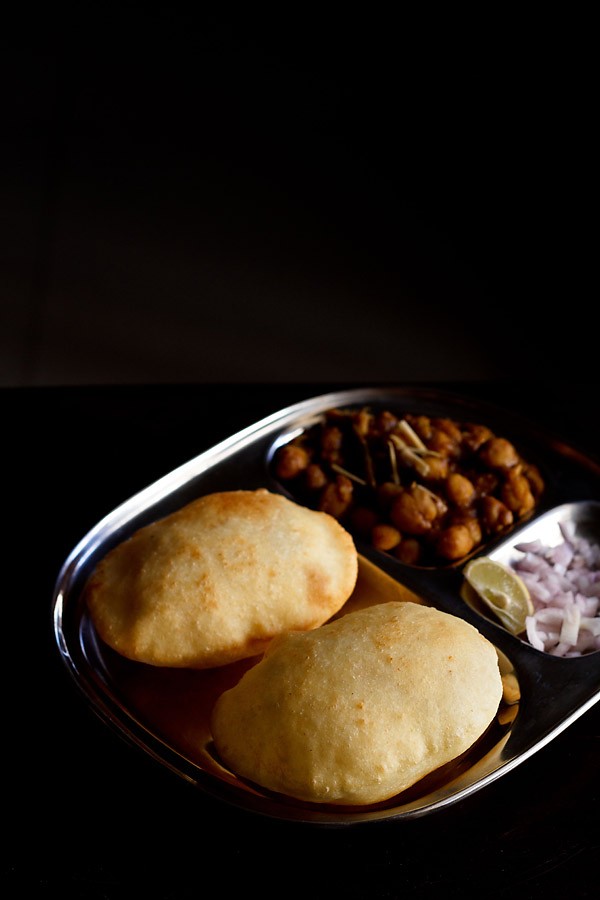
This instant bhatura is made with maida (all-purpose flour) and fine semolina (sooji or rava). I have also made the same recipe replacing rice flour with sooji (semolina). Both ways the bhature tasted good. The rice flour ones were softer even after cooling.
As I have mentioned above, baking soda and yogurt both act as leavening agents. You can add ¼ or ½ tsp of baking soda. I have used both the proportions of baking soda and they work fine.
How to make Instant Bhatura
1. Sieve all purpose flour (maida), salt and baking soda. Add the fine sooji (rava or semolina) & sugar.
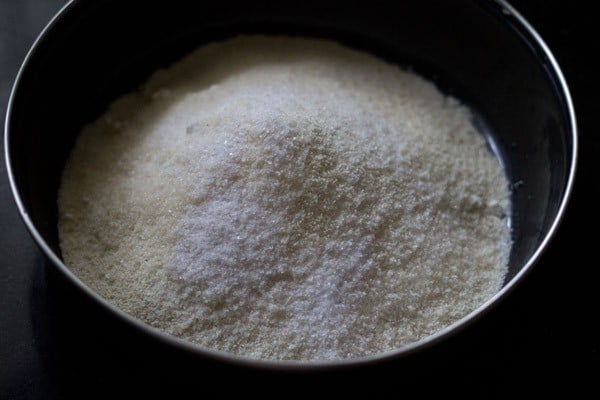
2. Add the yogurt and mix well.
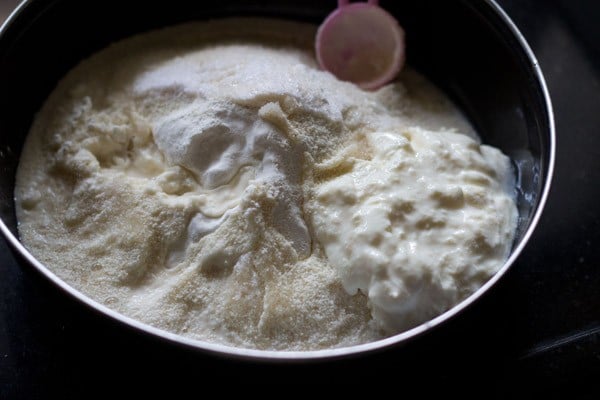
3. Add water in intervals and as required. Knead to a smooth and soft dough.
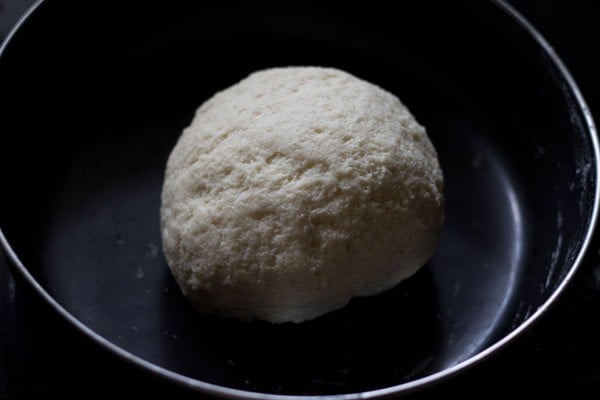
4. Cover the dough with a wet napkin and keep aside for 2 hours.
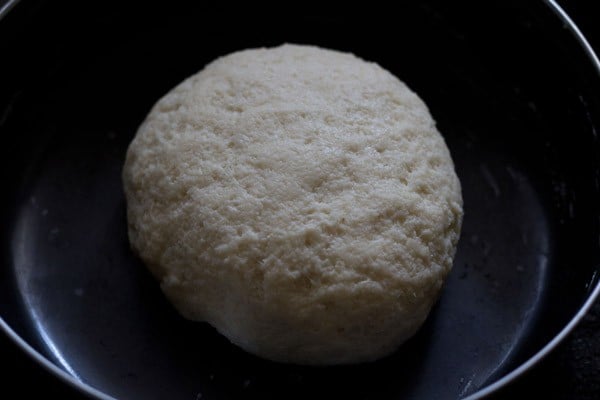
5. Make medium sized balls from the dough. Apply oil while rolling and roll into an oval or elongated shape.
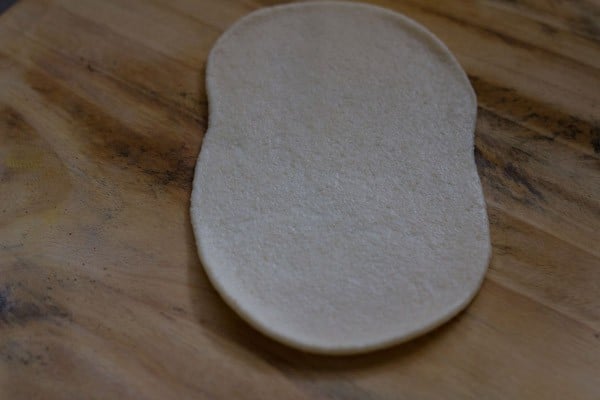
6. Drop the rolled dough in hot oil and it will start puffing within a minute. Fry at medium flame.
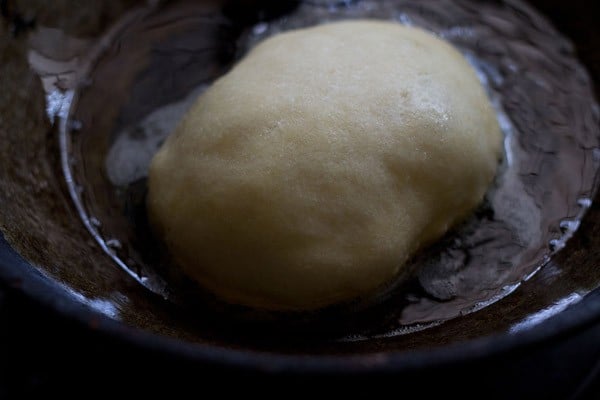
7. When the sizzling of the oil stops, turn over and fry the other side.
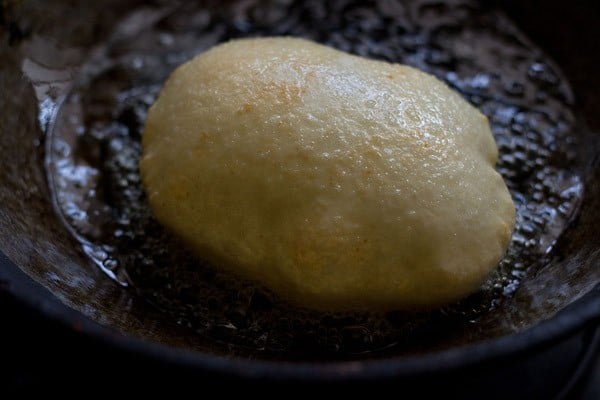
8. When light golden, remove and drain on paper towels to remove excess oil. Make all bhature this way.
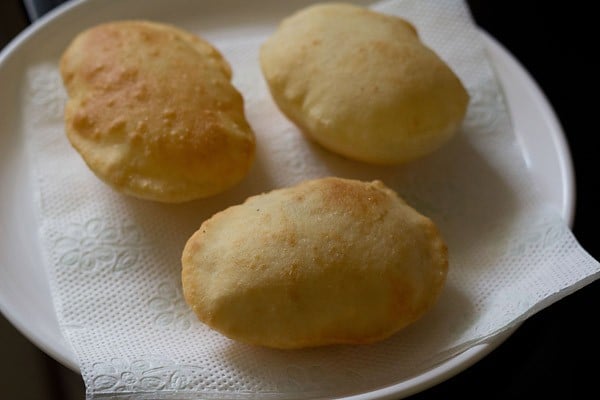
Serve them hot with any chana masala or chickpea curry.
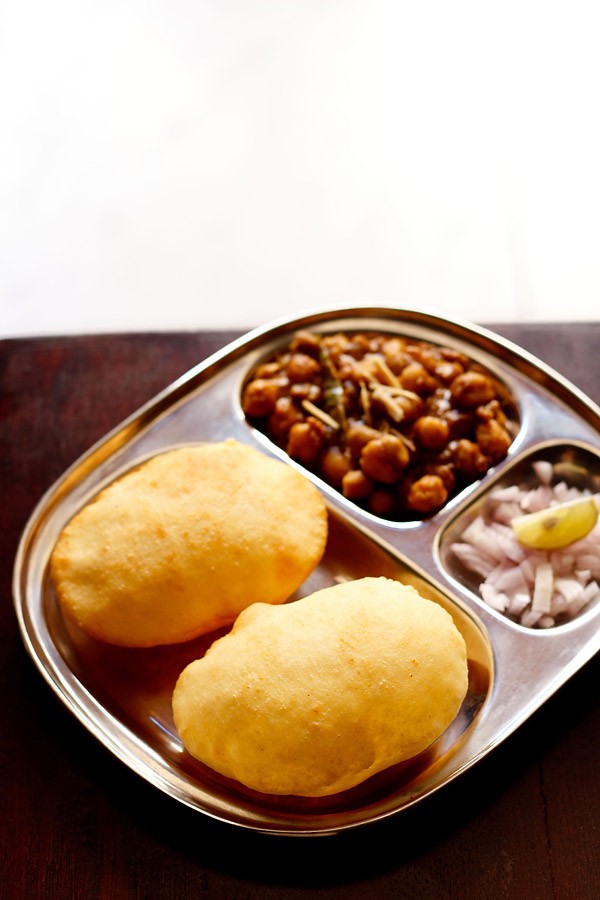
Few more tasty Indian breads for you!
Please be sure to rate the recipe in the recipe card or leave a comment below if you have made it. For more vegetarian inspirations, Sign Up for my emails or follow me on Instagram, Youtube, Facebook, Pinterest or Twitter.
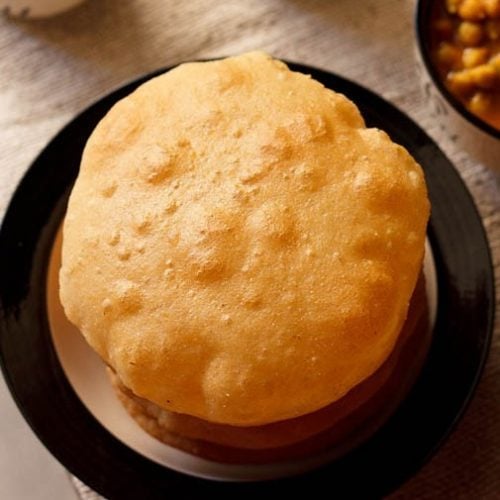
Bhatura Recipe (Naturally Fermented Bhature)
Ingredients
main ingredients
- 2.5 cups whole wheat flour (atta)
- 1 teaspoon salt or add as required
- 1 tablespoon oil or ghee or butter
- ⅓ or ½ cup lukewarm water – do not add hot water
- oil for deep frying
for overnight fermentation of dough
- ¾ cup Curd (yogurt or cashew curd), 150 ml curd
- ½ tablespoon sugar or brown sugar
- ½ teaspoon baking powder (alternative is – use ¼ teaspoon baking soda)
- ¾ cup all purpose flour (maida)
- ¼ cup water (optional)
Instructions
Preparation
- You will have to start the night before.
- In a bowl take the yogurt, sugar, baking powder and all purpose flour.
- Mix well all the above 4 ingredients mentioned for overnight fermentation.
- If the yogurt has whey in it, then don't need to add the ¼ cup water mentioned above.
- If the yogurt is thick, then to thin the batter, add ¼ cup water.
- Cover the bowl with a cloth and set it aside in a warm place overnight or for 8 to 9 hours to allow natural fermentation to take place.
- The next day you will see tiny bubbles on the surface of the mixture. The mixture is ready for the next step when tiny bubbles appear on the surface.
Kneading dough for Bhatura
- In another bowl, mix together the whole wheat flour (atta) with salt and rub the ghee or butter into it with your fingertips.
- Into this bowl, add the fermenting mixture and the warm water.
- Form a dough with these two mixtures.
- Knead the dough for 5 to 10 minutes or until it is silky smooth.
- Add a little flour if it is too wet. Gather the dough into a compact ball and cover it with a damp cloth. Again set it aside in a warm place for 2 hrs.
- After 2 hours, knead the dough again.
- Shape into 15 balls and roll them into 5 to 6-inch discs.
Frying Bhatura
- Heat oil or ghee and deep fry the bhature in the same way as you would fry pooris. the oil has to be moderately hot. Use medium to medium-high flame while frying.
- They will take a bit longer to fry than pooris. fry them till golden.
- Drain them on kitchen paper napkins to remove the excess oil.
- Continue to fry each bhature this way.
- Serve the bhatura hot with chana masala and wedges of lemon and sliced onions.
Notes
- Kneading: The dough has to be kneaded very well and should be soft and pliable. If the dough becomes sticky, then add some flour and continue to knead. Add water as required while kneading the dough. You can use a stand-mixer to knead the dough.
- Frying: Fry the bhatura on medium to medium-high heat. Do not fry on a very high heat as then then the top gets browned too much and can be slightly undercooked from inside Also, do not fry on low heat as then they absorb too much oil.
- Leavening Ingredients : As mentioned in the ingredients list you can use either ½ teaspoon baking powder or ¼ teaspoon baking soda.
- Serving Suggestions: Serve bhatura with chana masala or chickpea curry.
- Nutritional information is for 1 bhatura.
Nutrition Info (Approximate Values)
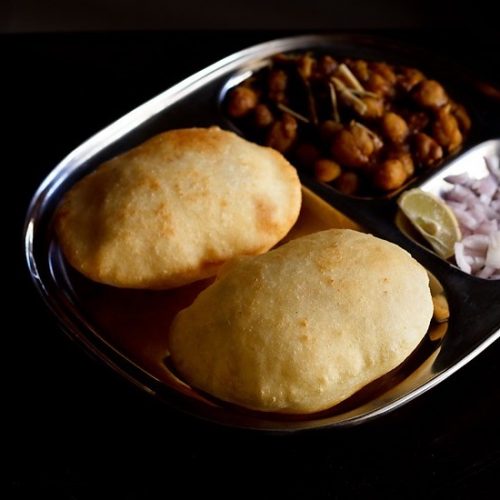
Instant Bhatura With Baking Soda
Ingredients
- 1.5 cups maida or all purpose flour
- ⅓ cup sooji (fine rava or fine semolina) or ½ cup rice flour
- ½ tablespoon oil or ghee
- ½ tablespoon sugar – fine or super fine
- ½ teaspoon salt or as required
- ¼ or ½ teaspoon baking soda
- ½ cup Curd (yogurt or dahi)
- water for kneading – as required
- oil for deep frying – as required
Instructions
Making Bhatura Dough
- Sieve the maida (all purpose flour) with baking soda and salt.
- Add the sooji and sugar. Mix well.
- Add the yogurt and mix again.
- Add very little water, just about ½ tbsp and begin to knead.
- Knead the dough, adding water as required. Make a smooth and soft dough.
- Cover the dough with a wet napkin and keep aside for 2 hours.
Frying Bhatura
- Heat oil in a kadai or pan for deep frying.
- Make small to medium sized balls from the dough.
- Roll the balls between your palms to make them even.
- Keep the balls covered with the wet kitchen napkin.
- Take a ball and flatten them. Apply oil on both sides and with a rolling pin roll, the ball into oval or elongated shape.
- Make neither thick nor thin bhature.
- Rotate the rolling board while rolling the bhature as it much easier than lifting it, since we are not using flour to roll them.
- When the oil is hot enough, place the rolled dough gently into the oil. It will puff up.
- Aid in puffing by applying light pressure on it with a slotted spoon.
- When the oil stops sizzling, turn oven and fry the second side.
- When light golden, remove and drain on kitchen paper towels to remove excess oil.
- Make the rest of the bhature this way. serve the instant bhatura hot with chana masala.
Notes
Nutrition Info (Approximate Values)
This Bhatura recipe from the archives first published in June 2010. It has been updated on November 2024.
